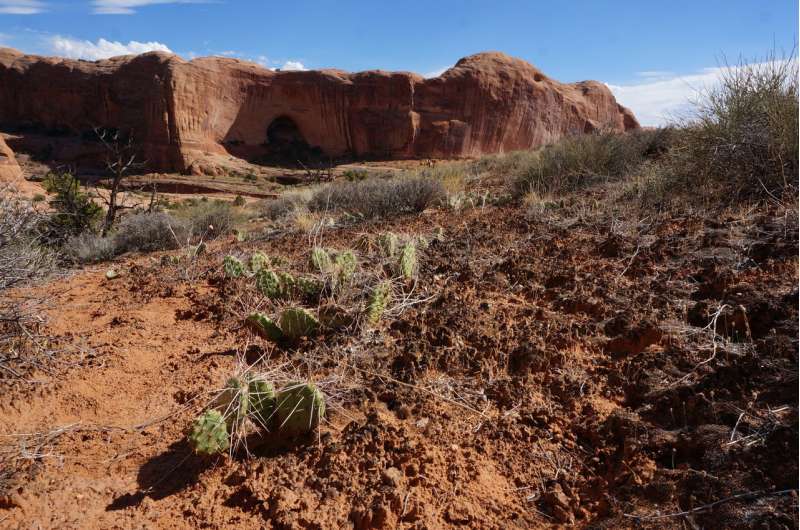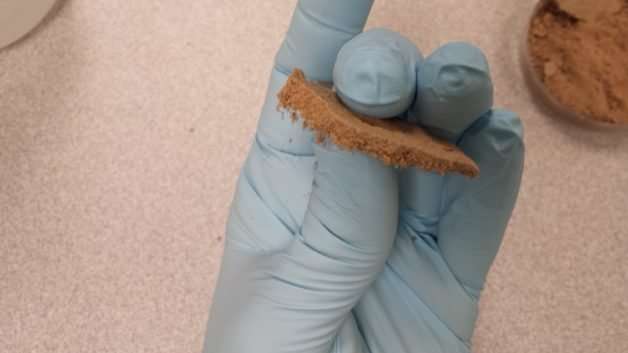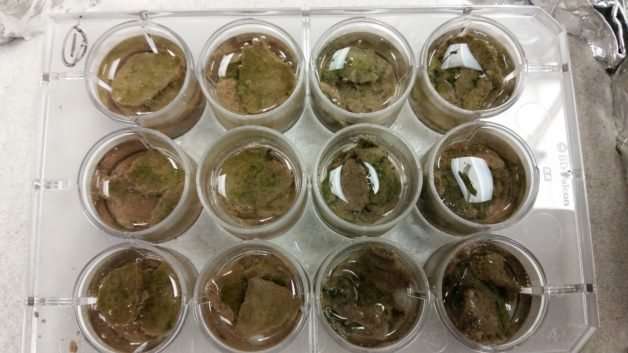Real world native biocrusts: Microbial metabolism

Arid lands, which cover some 40 percent of the Earth's terrestrial surface, are too dry to sustain much in the way of vegetation. But far from being barren, they are home to diverse communities of microorganisms—including fungi, bacteria, and archaea—that dwell together within the uppermost millimeters of soil. These biological soil crusts, or biocrusts, can exist for extended periods in a desiccated, dormant state. When it does rain, the microbes become metabolically active, setting in motion a cascade of activity that dramatically alters both the community structure and the soil chemistry.
"These biocrusts and other soil microbiomes contain a tremendous diversity of both microbes and small molecules ('metabolites'). However, the connection between the chemical diversity of soil and microbial diversity is poorly understood," said Trent Northen, a senior scientist at Lawrence Berkeley National Laboratory (Berkeley Lab).
In a paper published January 2, 2018, in Nature Communications, Berkeley Lab researchers led by the Northen lab report that specific compounds are transformed by and strongly associated with specific bacteria in native biological soil crust (biocrust) using a suite of tools Northen calls "exometabolomics." Understanding how microbial communities in the biocrusts adapt to their harsh environments could provide important clues to help shed light on the roles of soil microbes in the global carbon cycle.
The work follows a 2015 study that examined how specific small molecule compounds called "metabolites" were transformed in a mixture of bacterial isolates from biocrust samples cultured in a milieu of metabolites from the same soil. "We found that the microbes we investigated were 'picky' eaters," Northen said. "We thought we could use this information to link what's being consumed to the abundance of the microbes in the intact community, thereby linking the biology to the chemistry."

In the new study, the investigators set out to determine whether the microbe-metabolite relationships observed in the simplified test-tube system could be reproduced in a more complex soil environment. Biocrusts from the same source - representing four successive stages of maturation - were wet, and the soil water was sampled at five time points. The samples were analyzed by liquid chromatography-mass spectrometry (LC-MS) to characterize the metabolite composition ("metabolomics"), and biocrust DNA was extracted for shotgun sequencing to measure single copy gene markers for the dominant microbe species ("metagenomics").
"When we compare the patterns of metabolite uptake and production for isolated bacteria that are related to the most abundant microbes found in the biocrusts, we find that, excitingly, these patterns are maintained," said Northen. That is, increased abundance of a given microbe is negatively correlated with the metabolites that they consume and positively correlated with metabolites that they release.
When active, biocrusts take up atmospheric carbon dioxide and fix nitrogen, contributing to the ecosystem's primary productivity. They also process organic matter in soil, modifying key properties related to soil fertility and water availability.

"This study suggests that laboratory studies of microbial metabolite processing can help understand the role of these microbes in carbon cycling in the environment. This study gets us closer to understanding the complex food webs that are vital in nutrient dynamics and overall soil fertility," said study first author Tami Swenson, a scientific engineering associate in Northen's group within the Berkeley Lab Biosciences Area's Environmental Genomics and Systems Biology (EGSB) Division.
Northen's group is currently working on expanding these studies to capture a greater fraction of microbial diversity. Ultimately, this may enable the prediction of nutrient cycling in terrestrial microbial ecosystems, and perhaps even manipulation by adding specific metabolites.
More information: Tami L. Swenson et al. Linking soil biology and chemistry in biological soil crust using isolate exometabolomics, Nature Communications (2017). DOI: 10.1038/s41467-017-02356-9
Journal information: Nature Communications
Provided by Lawrence Berkeley National Laboratory




















